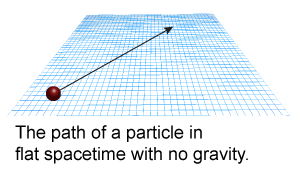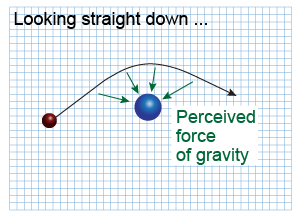|
The theory of special relativity was discussed at the end of Chapter 3. It tells us that the speed of light is the same for all observers whether or not they are moving. To make the equivalence principal true for experiments that measure the speed of light, two things must be true: - Space itself must be curved.
- The path of light must be deflected by gravity, even though light has no mass.

|
 What is curved space? To understand it without mathematics, consider rolling a ball along a flat sheet of graph paper on a level table. The ball rolls along a straight line. The flat graph paper is like “flat space.” Flat space is what you would consider “normal.” In flat space, parallel lines never meet and the three angles of a triangle add up to 180°.
What is curved space? To understand it without mathematics, consider rolling a ball along a flat sheet of graph paper on a level table. The ball rolls along a straight line. The flat graph paper is like “flat space.” Flat space is what you would consider “normal.” In flat space, parallel lines never meet and the three angles of a triangle add up to 180°. 
|
 A large mass, such as a star, causes space to curve in the region nearby. Imagine a graph paper printed on a sheet of rubber. Imagine a heavy mass representing the effect of a star. The “star” deforms the flat space of the graph paper. If you roll a ball along this “curved” graph paper, it bends as it passes by the “well” created by the mass.
A large mass, such as a star, causes space to curve in the region nearby. Imagine a graph paper printed on a sheet of rubber. Imagine a heavy mass representing the effect of a star. The “star” deforms the flat space of the graph paper. If you roll a ball along this “curved” graph paper, it bends as it passes by the “well” created by the mass. 
|
Graph paper is two dimensional, but the effect of mass on three-dimensional space is similar. In curved space, parallel lines may meet and the angles of a triangle may not add up to 180°! 
|
 From directly overhead, the deformed graph paper looks square. If you could only look straight down, the path of the ball appears to be deflected by a force pulling it toward the center. You could create an equation describing the motion of the ball as accelerated by the force of gravity. As Newton did, you would be right. The effect of curved space is identical to the force of gravity.
From directly overhead, the deformed graph paper looks square. If you could only look straight down, the path of the ball appears to be deflected by a force pulling it toward the center. You could create an equation describing the motion of the ball as accelerated by the force of gravity. As Newton did, you would be right. The effect of curved space is identical to the force of gravity. 
|
Close to a large mass, the curvature of space causes straight lines to become orbits. A planet in an orbit is actually moving in a straight line through curved space. This is a strange way to think, but the experimental evidence tells us it is the right way to think. Einstein was not a household name when general relativity was published, and few physicists could follow the math to understand the theory. Convinced that he was right, however, Einstein predicted that light from distant stars would be bent by passing near the Sun. What made Einstein famous was Sir Arthur Eddington’s 1919 confirmation of the bending of starlight by the Sun. 
|

